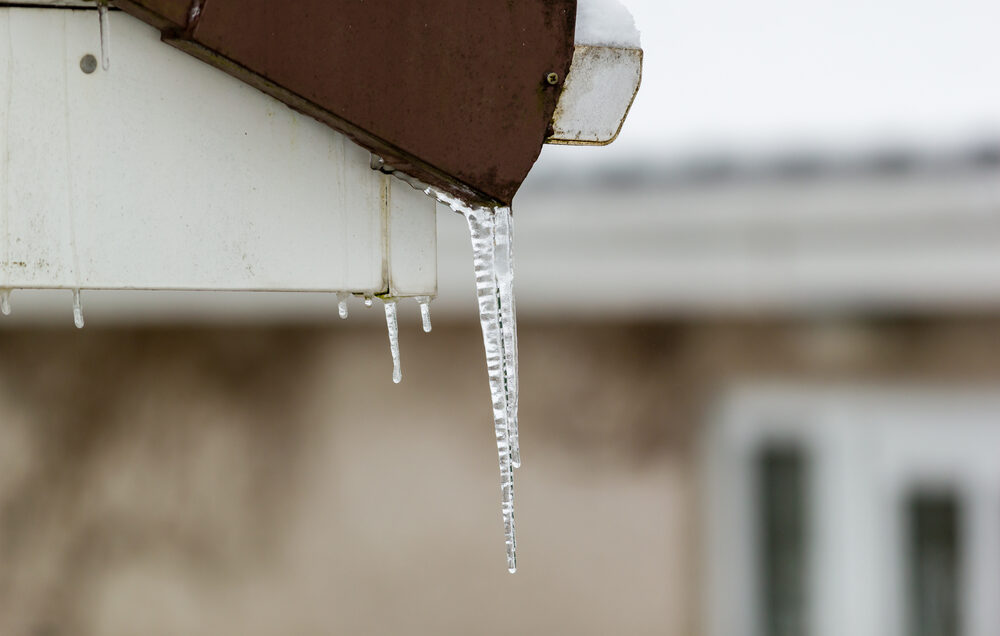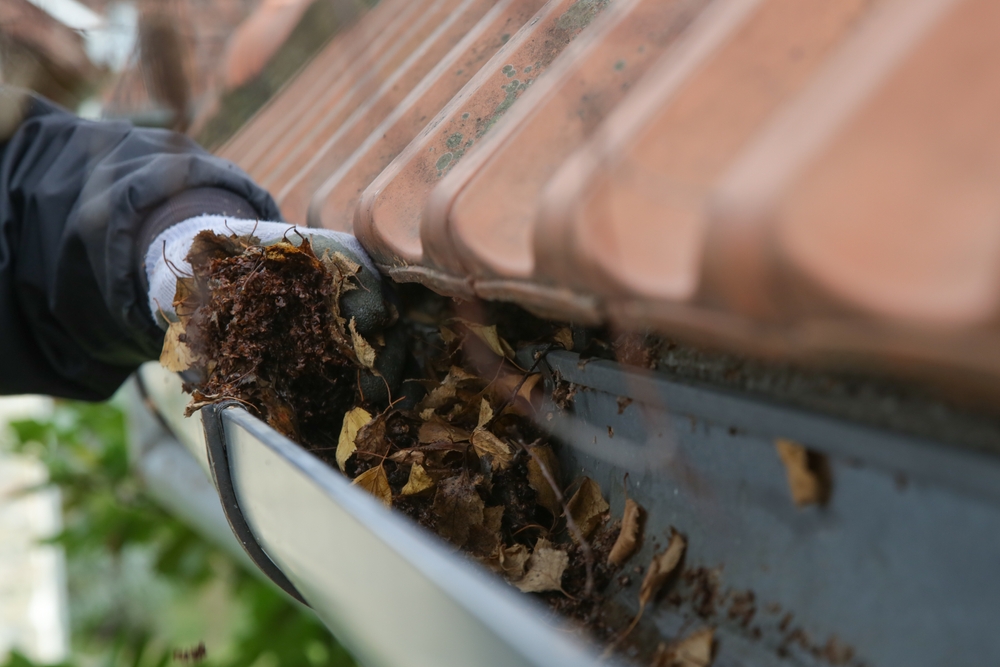Winter brings a combination of heavy rainfall, frost, ice, and occasional snow – all of which place extra pressure on your guttering system.
Gutters that are not properly prepared can quickly become overwhelmed, resulting in leaks, water damage, and even structural concerns. Taking the time to get your gutters ‘winter-ready’ is one of the simplest and most effective ways to protect your home during the colder months.
This comprehensive guide will help you understand why preparation matters and how to carry out essential maintenance before the winter weather sets in.
Key Takeaways
- Preparing gutters before winter prevents blockages, overflow, and damage caused by heavy rain, frost, and ice.
- Thorough cleaning and detailed inspection help identify cracks, loose joints, and hidden obstructions that could worsen in cold weather.
- Managing nearby trees and checking roof condition reduces the amount of debris entering the system and minimises winter-related risks.
- Ensuring downpipes and drainage routes function properly keeps water flowing safely away from the property throughout the season.
Why Winter Gutter Preparation is Important
Winter conditions magnify existing weaknesses in guttering systems. When gutters or downpipes are blocked or damaged, water cannot flow freely and is more likely to overflow or freeze. This leads to several potential issues that homeowners should be aware of.
What Could Happen if Gutters Are Not Prepared?
- Water overflowing from blocked gutters can run down exterior walls, causing damp, mould, and damage to brickwork.
- Frozen debris within the gutter adds weight, leading to sagging or detachment.
- Standing water can freeze and form ice dams, which prevent further drainage and direct water under the roof tiles.
- Blocked downpipes can cause water to pool near the foundation of the property, increasing the risk of flooding or structural weakening.
- Minor cracks or loose brackets can worsen in freezing conditions, leading to more extensive and expensive repairs.
Preparing your gutters before winter helps prevent these problems and ensures your roof drainage system works efficiently throughout the season.

How to Prepare Your Gutters for the Winter
Preparing your gutters for the winter requires careful inspection, cleaning, and preventive adjustments. The following steps outline practical tips to ensure your gutters are ready to cope with the colder months.
Clear Out All Debris Thoroughly
Cleaning the gutters is the most important first step because any debris left inside the gutters can disrupt the entire drainage system once winter weather arrives. Leaves, moss, seed pods, and small twigs tend to absorb water and become heavy. When temperatures drop, this debris can freeze into solid blocks, preventing water from moving through the system and increasing the risk of overflow.
When clearing your gutters, it is essential to take your time and work methodically.
- Begin by removing larger debris by hand, using gloves and a small scoop where necessary.
- Work from one end of the gutter to the other to avoid leaving material behind.
- Once the bulk of the debris has been cleared, flush the entire gutter with clean water to remove smaller particles and confirm smooth water flow.
- Observe whether water pools in any area, as this can indicate a hidden blockage or a sagging section that needs correction.
For homeowners who prefer professional help or cannot safely access their gutters, Sam’s Gutters provides comprehensive gutter cleaning services, ensuring that your system is fully cleared and ready for the colder months ahead.
Inspect for Damage or Weak Spots With Close Attention to Detail
Any existing issue, no matter how minor, can worsen significantly once exposed to freezing temperatures, strong winds, and heavy rainfall. Conduct a careful inspection of each component of the guttering system, including:
- Cracks or hairline fractures, which often widen during frost.
- Joints that appear slightly separated or show signs of dried or degraded sealant.
- Brackets that have loosened or bent under the weight of previous debris.
- Sagging sections where water may pool rather than flow evenly.
Addressing weaknesses early ensures the system remains robust throughout the season.
Check Downpipes for Obstructions and Winter Flow Capacity
Downpipes frequently become blocked without showing any obvious external signs. Even a mild obstruction can cause water to back up in the gutter, resulting in spillover or ice formation. Winter weather amplifies these risks, as trapped water within the downpipe can freeze, expand, and cause cracks or complete blockages.
To ensure the system is functioning correctly:
- Pour water into the gutter and observe how efficiently it drains through the downpipe.
- If water drains slowly, the obstruction may be at a bend, joint, or in the lower section where debris commonly accumulates.
- Clear any blockages using appropriate tools, or seek professional assistance if the issue cannot be accessed safely.
Trim Back Nearby Trees to Reduce Debris
Trees create a continuous supply of organic debris that ends up in gutters, especially during autumn. However, the problem does not end when the leaves fall. Winter storms can dislodge twigs and branches, while strong winds can cause overhanging branches to scrape or damage the roof and guttering.
Trimming nearby trees before winter offers several benefits:
- It reduces the volume of debris entering the gutters throughout the season.
- It lowers the likelihood of storm damage caused by falling branches.
- It prevents branches from brushing against roof tiles and loosening material that may later fall into the gutter.
By managing the trees surrounding your property, you reduce maintenance demands and protect both the guttering and the roof from preventable winter damage.
Check the Roof Condition from Ground Level
While the focus is on gutters, the condition of the roof has a direct impact on how well the guttering system performs. A roof with loose tiles, damaged flashing, or extensive moss buildup will shed debris more frequently. It might also allow water to enter the guttering at angles it was not designed to handle, increasing the risk of overflow.
A ground-level inspection can reveal:
- Slipped or missing tiles indicate that water may be escaping in unexpected areas.
- Flashing that appears raised or weathered, potentially allowing water to run behind the gutter.
- Moss growth that may dry out, fall into the gutter, and create blockages.
Addressing roof issues early ensures that the guttering system receives only the water it is designed to carry and not additional debris or runoff caused by roof deterioration.
Ensure Water Drains Away From the Property
Even if the guttering and downpipes function correctly, problems can arise if water is not being discharged far enough away from the home. Winter rainfall often saturates the ground, and poor drainage can lead to water pooling near the foundation or seeping into the lower walls.
To improve drainage:
- Inspect where each downpipe releases water and ensure it does not flow directly onto paved surfaces or soil next to the property.
- Consider installing downpipe extenders or drainage channels if necessary.
- Ensure that any existing drainage grates, soakaways, or underground channels are clear and functioning.
Consider Installing Gutter Guards
Gutter guards can be particularly beneficial in properties surrounded by trees or exposed to frequent debris. While they do not eliminate the need for maintenance, they significantly reduce the amount of material that enters the gutters, making winter preparation easier and helping the system cope with winter rainfall.
- They prevent large debris from clogging the gutter channel.
- They reduce the frequency of required cleaning, especially during autumn and early winter.
- They encourage water to flow more evenly during heavy rainfall.
| Preparation Step | Purpose | Benefit in Winter |
|---|---|---|
| Clear debris | Remove leaves, moss, and dirt | Prevents blockages and overflow |
| Inspect for damage | Check for cracks, leaks, and loose brackets | Reduces risk of system failure in cold weather |
| Check downpipes | Ensure full water flow through pipes | Prevents water backing up and freezing |
| Trim nearby trees | Reduce falling debris | Minimises blockages and roof damage |
| Check roof condition | Identify missing tiles or damage | Prevents leaks and excess debris entering gutters |
| Ensure proper drainage | Direct water away from property | Prevents damp, flooding, and foundation damage |
| Install gutter guards | Reduce debris accumulation | Helps water flow more consistently |
FAQs for Gutter Preparation for Winter
How often should gutters be cleaned before winter?
Gutters should ideally be cleaned in late autumn once the majority of leaves have fallen. If your home is surrounded by trees, you may need to clean more frequently.
Can I prepare my gutters myself?
Many tasks can be completed safely by homeowners, but professional services are recommended if the property is tall, the gutters are heavily blocked, or damage is suspected.
What are the signs that gutters need attention?
Common signs include overflowing water, visible sagging, staining on exterior walls, dripping joints, and water pooling at the base of the property.
Do gutter guards eliminate the need for maintenance?
No. Gutter guards reduce the amount of debris entering the system, but cleaning and inspections are still required.
What should I do if my gutters freeze?
Avoid trying to break the ice yourself. This may cause damage. Instead, wait for temperatures to rise or seek assistance from a professional if water is not draining afterwards.
Schedule a Professional Inspection: Sam’s Gutters
While homeowners can carry out basic maintenance, a professional inspection provides reassurance that no hidden issues have been missed, especially in properties that require specialised services such as gutter repair London or gutter cleaning London.
Sam’s Gutters offers expert gutter cleaning, repairs, and roof inspections carried out by trained specialists. A professional inspection ensures that your gutters and roof are prepared for harsh weather, reducing the likelihood of leaks, damage, and costly emergency repairs.
Contact Sam’s Gutters today to schedule your winter inspection and protect your property throughout the colder months.



